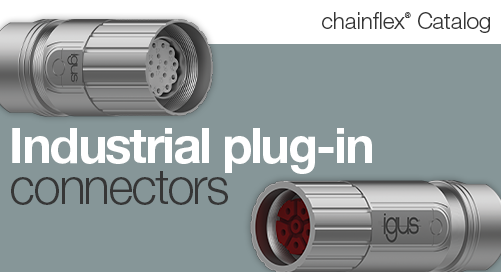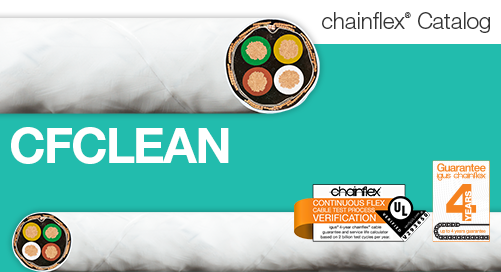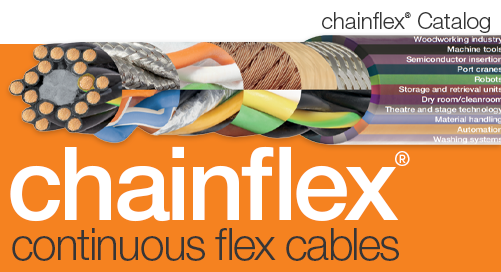How are chainflex® cables compliant with NFPA 79?
So, you want to know how our cables are compliant with NFPA 79. It’s a good question to ask, and you’ve come to the right place for answers. Here, we’ll explain seven ways that chainflex® cables meet the requirements of the relevant sections in NFPA 79 that address cables used in flexing applications.
A quick refresher on NFPA 79
NFPA 79 is the electrical standard for industrial machinery. It “provides safeguards…to protect operators, equipment, facilities, and work-in-progress from fire and electrical hazards.”
The standard is in place to complement the NEC (NFPA 70) and offer more specific guidance concerning industrial machines. This standard is a great guideline for moving applications and cable management systems needed to supply power and other media machines.
NFPA 79 is revised every 3-4 years and is edited by a technical committee of professionals in related fields. New developments in the field are considered with each revision.
Let us take you for a tour through the NFPA 79 2021 code. We will break down the code sections that reference moving applications and cable management systems.
7 ways chainflex® cables comply with NFPA 79 2021
1) Section 4.4.2.8—Circuits supplied from power conversion equipment
This section states “electrical conductors and equipment supplied by power conversion equipment as part of adjustable speed drive systems and servo drive systems shall be identified as suitable for the electrical power characteristics and in accordance with any instruction provided by the manufacturer(s).”
Our power cables use a low capacitance composite insulation designed for all motor power applications. They can handle variable frequencies as well as changes in temperature, current and voltage.
There are further recommendations in Annex A of the NFPA79 code. Section A.12.1.1 outlines typical operations conditions and talks about the external influences to consider when specifying a motor cable.
igus® has specified power cables into thousands of motor applications worldwide with zero defects or complaints about mechanical or electrical performance.
2) Section 12.7—Conductors and cables used for flexing applications
Section 12.7.1.1 states “conductors and cables used for flexing applications shall be selected from Table 12.2.2.” with an exception stating, “special cables and conductors identified as suitable for flexing applications shall be permitted.”
chainflex® cables meet the requirement for the number of strands allowed for use in flexing applications. We have also tested and proven all our chainflex® cable designs. We know the stranding is an important part of the cable design for flexing, but it is not the sole contributor to the life cycle of the cable.
3) Section 12.7.1.2—Cable requirements for severe duties
This section states “cables subjected to severe duty shall be constructed to protect against 1. abrasion due to mechanical handling and dragging across rough surfaces, 2. kinking due to operation without guides, and 3. stress resulting from guide rollers and forced guiding and being wound and rewound on drums.”
chainflex® cables are designed and tested to be resistant to both abrasion and kinking. Check out examples of our abrasion and long travel testing here.
4) Section 12.7.2—Mechanical rating
This section states “the cable handling system shall be designed to keep tensile stress of the conductors as low as practicable during the machines operations. The tensile strength shall not exceed manufacturers specifications.”
e-chain® cable carriers and chainflex® cables offer customers a complete solution to reducing the tensile stress of moving cables. We have proven guidelines for proper placement and spacing of cables inside e-chains®, as well as detailed recommendations and products to help achieve proper strain relief and securing of cables.
5) Section 12.9—Special cables and conductors
Section 12.9.2 states “AWM shall be permitted under certain conditions, either as 1. part of an assembly identified for use (harnessed cable that carries a listing or UL Mark), 2. where AWM is used in approved equipment in accordance with manufacturer, or 3. where constructed in accordance to section 12.2 - 12.6. which address the conductor stranding, flame resistance of the insulation and jacket, and minimum thickness of the insulation and jacket in compliance too UL AWM”
chainflex® cables are compliant with the NFPA 79 standard and carry the correct agency approvals for industrial cabling systems.
6) Section 13.4.3—Connection to moving elements of the machine
This section is largely focused on protection using cable handling systems, following bend radius factors, and using proper cables designed for flexing.
chainflex® meets the recommendations for protecting moving cables. igus® also offers detailed guidance for moving cable installations above and beyond the standard.
7) Section 13.4.3.2—Cable handling system
This section states “devices serving to guide and carry a cable with flexible properties shall be designed so that the inner bending radius is not less than the values given in Table 13.4.3.2.3,” which makes recommendations based on cable diameter and type of cable management system. There is an exception—smaller bend radii are acceptable if cable is identified for a special purpose.
chainflex® cables meet the bend radius recommendations of the standard. igus® also has a more detailed bend radius recommendation based on ambient temperature and target cable life for the application. We have a life cycle calculator that uses other mechanical and environmental factors to provide a bend radius factor as related to life cycle of the cable.
For more information, contact a chainflex® cable expert. You can also call us at 800-521-2747.



